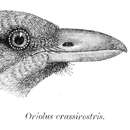Biology
provided by Arkive
All orioles belonging to the Oriolidae family feed on insects and fruit, and most build deep, cup-shaped nests in the fork of a branch (4).
Conservation
provided by Arkive
The protection of the São Tomé oriole's forest habitat appears to be critical to its long-term survival. A national park and a zona ecologica (ecological zone) have been proposed but await ratification (2) (6). The protection of lowland primary forest has been particularly recommended (2), but the protection of secondary forest, especially mature areas, is also required (5). Hopefully protected areas will be established before the São Tomé oriole becomes another victim of habitat loss.
Description
provided by Arkive
Orioles are fairly large, boldly coloured, woodland and forest birds; only one species of oriole occurs on the island of São Tomé (3). Male São Tomé orioles have black heads and pale olive plumage on the upperparts, with darker wings and tail and greyish-white underparts. Touches of greyish-yellow decorate the back of the neck and the tip of the tail. Females, however, lack the bold black head and, like juveniles, have pale streaks across a darker breast (2) (3). Both sexes have a down-curved pink-red bill (2) (4), and are often detected by their loud ringing song (3)
Habitat
provided by Arkive
The majority of the São Tomé oriole population occurs in lowland primary forest, but it also inhabits mid- to high-altitude forest and mature secondary forest (2) (5).
Range
provided by Arkive
Endemic to São Tomé, off the western equatorial coast of Africa. The São Tomé oriole occurs throughout the island except in the north-east (2).
Status
provided by Arkive
Classified as Vulnerable (VU) on the IUCN Red List 2007 (1).
Threats
provided by Arkive
Following human colonisation, large areas of forest on São Tomé were cleared for cultivation, with 42 percent of the land being given to cocoa cultivation (5). During the 1970s, enormous quantities of pesticides were used in these cocoa plantations, greatly reducing the population of the oriole. The oriole had some chance to recover when, following a crash in cocoa prices in 1975, many cocoa plantations were abandoned and the land regenerated into secondary forest, providing suitable habitat for several endemic birds, including the São Tomé oriole (5). However, the oriole population has not fully recovered from these declines and is constantly threatened by the possibility of old plantations being brought back into production, or developed for different types of agriculture, which would almost certainly involve an increase in pesticide use (5).
The montane primary forest of the island is at immediate risk from encroaching agriculture, and any further loss of this vital habitat would seriously endanger the São Tomé oriole (5). Secondary forest on Sao Tome is also threatened by the development of agriculture and an increasing demand for timber (5). In addition, the development of roads on the island is opening up previously remote areas (2), increasing the chance of habitat loss and degradation.
São Tomé oriole
provided by wikipedia EN
The São Tomé oriole (Oriolus crassirostris), or great-billed oriole, is a species of bird in the family Oriolidae. The species was named by Gustav Hartlaub in 1857. It is endemic to the island of São Tomé.[1] Its natural habitats are subtropical or tropical moist lowland forests and subtropical or tropical moist montane forests. It is threatened by habitat loss.
Distribution and habitat
It is widely distributed throughout the island of São Tomé, except the northeast (the urban area of São Tomé). It is most abundant in the southwest and on the central massif.[1]
Threats
The São Tomé oriole is threatened by habitat loss of the remaining lowland rainforest of São Tomé.[2]
References

- license
- cc-by-sa-3.0
- copyright
- Wikipedia authors and editors
São Tomé oriole: Brief Summary
provided by wikipedia EN
The São Tomé oriole (Oriolus crassirostris), or great-billed oriole, is a species of bird in the family Oriolidae. The species was named by Gustav Hartlaub in 1857. It is endemic to the island of São Tomé. Its natural habitats are subtropical or tropical moist lowland forests and subtropical or tropical moist montane forests. It is threatened by habitat loss.
- license
- cc-by-sa-3.0
- copyright
- Wikipedia authors and editors

